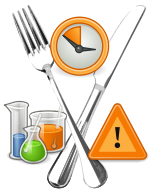Food safety
Food safety[1] is a scientific discipline describing handling, preparation, and storage of food in ways that prevent foodborne illness. This includes a number of routines that should be followed to avoid potentially severe health hazards. Food can transmit disease from person to person as well as serve as a growth medium for bacteria that can cause food poisoning. In developed countries there are intricate standards for food preparation, whereas in lesser developed countries the main issue is simply the availability of adequate safe water, which is usually a critical item.[2] In theory food poisoning is 100% preventable. The five key principles of food hygiene, according to WHO, are:[3] Prevent contaminating food with pathogens spreading from people, pets, and pests. Separate raw and cooked foods to prevent contaminating the cooked foods. Cook foods for the appropriate length of time and at the appropriate temperature to kill pathogens. Store food at the proper temperature. Do use safe water and cooked materials.

ISO 22000 is a standard developed by the International Organization for Standardization dealing with food safety. This is a general derivative of ISO 9000. ISO 22000 standard: The ISO 22000 international standard specifies the requirements for a food safety management system that involves interactive communication, system management, prerequisite programs, HACCP principles. [edit]Incidence A 2003 World Health Organization (WHO) report concluded that about 30% of reported food poisoning outbreaks in the WHO European Region occur in private homes.[4] According to the WHO and CDC, in the USA alone, annually, there are 76 million cases of foodborne illness leading to 325,000 hospitalizations and 5,000 deaths.[5] In 2003, the WHO and FAO published the Codex Alimentarius which serves as a guideline to food safety.[6] Australian Food Authority is working toward ensuring that all food businesses implement food safety systems to ensure food is safe to consume in a bid to halt the increasing incidence of food poisoning, this includes basic food safety training for at least one person in each business. Smart business operators know that basic food safety training improves the bottom line, staff take more pride in their work; there is less waste; and customers can have more confidence in the food they consume. Food Safety training in units of competence from a relevant training package, must be delivered by a Registered Training Organization (RTO) to enable staff to be issued with a nationally recognised unit of competency code on their certificate. Generally this training can be completed in less than one day. Training options are available to suit the needs of everyone. Training may be carried out in-house for a group, in a public class, via correspondence or online. Basic food safety training includes: Understanding the hazards associated with the main types of food and the conditions to prevent the growth of bacteria which can cause food poisoning The problems associated with product packaging such as leaks in vacuum packs, damage to packaging or pest infestation, as well as problems and diseases spread by pests. Safe food handling. This includes safe procedures for each process such as receiving, re-packing, food storage, preparation and cooking, cooling and re-heating, displaying products, handling products when serving customers, packaging, cleaning and sanitizing, pest control, transport and delivery. Also the causes of cross contamination. Catering for customers who are particularly at risk of food-borne illness, including allergies and intolerance. Correct cleaning and sanitizing procedures, cleaning products and their correct use, and the storage of cleaning items such as brushes, mops and cloths. Personal hygiene, hand washing, illness, and protective clothing. People responsible for serving unsafe food can be liable for heavy fines under this new legislation, consumers are pleased that industry will be forced to take food safety seriously. [edit]China Main article: Food safety in the People's Republic of China Food safety is a growing concern in Chinese agriculture. The Chinese government oversees agricultural production as well as the manufacture of food packaging, containers, chemical additives, drug production, and business regulation. In recent years, the Chinese government attempted to consolidate food regulation with the creation of the State Food and Drug Administration in 2003, and officials have also been under increasing public and international pressure to solve food safety problems. However, it appears that regulations are not well known by the trade. Labels used for "green" food, "organic" food and "pollution-free" food are not well recognized by traders and many are unclear about their meaning. A survey by the World Bank found that supermarket managers had difficulty in obtaining produce that met safety requirements and found that a high percentage of produce did not comply with established standards.[7] Traditional marketing systems, whether in China or the rest of Asia, presently provide little motivation or incentive for individual farmers to make improvements to either quality or safety as their produce tends to get grouped together with standard products as it progresses through the marketing channel. Direct linkages between farmer groups and traders or ultimate buyers, such as supermarkets, can help avoid this problem. Governments need to improve the condition of many markets through upgrading management and reinvesting market fees in physical infrastructure. Wholesale markets need to investigate the feasibility of developing separate sections to handle fruits and vegetables that meet defined safety and quality standards.